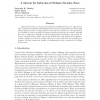Free Online Productivity Tools
i2Speak
i2Symbol
i2OCR
iTex2Img
iWeb2Print
iWeb2Shot
i2Type
iPdf2Split
iPdf2Merge
i2Bopomofo
i2Arabic
i2Style
i2Image
i2PDF
iLatex2Rtf
Sci2ools
108
Voted
IJCAI
1993
1993
Induction of Oblique Decision Trees
This article describes a new system for induction of oblique decision trees. This system, OC1, combines deterministic hill-climbing with two forms of randomization to nd a good oblique split
in the form of a hyperplane
at each node of a decision tree. Oblique decision tree methodsare tuned especially for domains in which the attributes are numeric, although they can be adapted to symbolic or mixed symbolic numeric attributes. We present extensive empirical studies, using both real and arti cial data, that analyze OC1's ability to construct oblique trees that are smaller and more accurate than their axis-parallel counterparts. We also examine the bene ts of randomization for the construction of oblique decision trees.
Related Content
| Added | 02 Nov 2010 |
| Updated | 02 Nov 2010 |
| Type | Conference |
| Year | 1993 |
| Where | IJCAI |
| Authors | David G. Heath, Simon Kasif, Steven Salzberg |
Comments (0)

